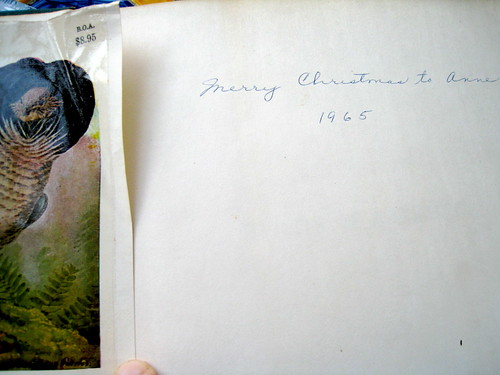 |
| Cape May Warbler in The Crossley ID Guide, p. 411 alongside Birds of America, plate 95 |
You're not gonna get this book into the pocket of your birding vest—it's bigger than The Joy of Cooking. I own only one bird book that larger and heavier than The Crossley ID Guide: the reprint of the 1917 Birds of America I got for Christmas in 1965. Edited by T. Gilbert Pearson, with color plates by Louis Agassiz Fuertes, its dust jacket proclaims in all caps, "This is the perfect, permanent bird book for all ages." Did the publisher mean it was perfect for a 14-year old as well as a 41-year old? Stone Age as well as Bronze Age? Industrial as well as Digital?
Like Fuertes' published paintings in Birds of America, Richard Crossley's plates are large, showing the species shown in its typical habitat. Crossley is not a painter however, his color plates are composite photos. Numerous photos of the bird are set against a background of the typical habitat. In the foreground of the of the composition appear a few close-up photos of the bird, each in a different plumage. In many plates, the middle ground displays several images of the bird in flight. In the distance are proportionally small images of the same species. Crossely's purpose is to pack as much identification information about the species into one scene as he can; how it may appear in flight, at rest from the side, viewed from the front when feeding, in the distance where streaks seem to blend into a wash of color.
At first I found these scenes a bit like a backlot studio shot in an old movie—I was distracted by the background. The more I looked at the page however, the more the images appeared 3-dimensional. Crossley is not trying to depict field marks. He asks the reader to look over the complete image, focusing first on this bird, then that, putting those photos of variable plumages and postures into context. In Japanese films, the director often gives the audience a wider shot than we're used to with Hollywood movies; the viewer, not the director, decides what to look at within the frame. Crossley's approach is more Kurosawa than Corman.
It will take me a long time to go through this book, but I'll use one plate as an example of the role this book can play in your birding toolbox. When I first moved to Kirkwood in the 80s, I occasionally saw what I called "the mystery bird." Its wings were swept back like a gull, but the tail wasn't the right shape for a gull. Sometimes I'd see a distant bird with a leading edge so straight that it appeared to be headless. It's flight was so effortless and acrobatic, I thought it might be a falcon. All of these are shown in the tiny distance shots on page 239.
 |
| Ruffed Grouse peers in from the dust jacket to read the 1965 version of an interactive comment. |
The fact that I can point you toward that page whether you own the book or not is another feature of this birding guide that Peterson and Pearson never dreamed of; it's interactive! I can try to soak it all the images on the printed page, but if I need more information, I can find it with a click on the website. The web version has labels, comments, and questions not included in the book. Of course, you can "like" it, make comments, or leave questions for the author on Facebook too. Adjusted for inflation, at $8.95, Birds of America was roughly 3 times the Amazon price of The Crossley ID Guide!
If you wrote about this book on the web and I haven't listed you below, I'd love it if you'd comment and give us the link!
10,000 Birds
The Bird Chaser and second post
Audubon Magazine
Birdzilla.com
Monarch's Nature Blog
The Bird Booker Report
Sapsucker Woods (gift shop of Cornell U)
What Bird Forum
Great review, I think you captured what Crossley was trying to do very nicely.
ReplyDeletebtw, here's my initial review
I've seen a lot of reviews of this recently and I'm definitely intrigued.
ReplyDeleteThanks, Birder's Library! Sorry I didn't include a link to your review in my post above. I hope everyone will check the Birder's Library review post--it's very detailed and thought-provoking, followed by a lively discussion.
ReplyDeleteYou might want to visit another great review and discussion from Cyberthrush.
ReplyDeleteHi Anne, you make some great observations about this exciting new guide. I have a couple small concerns with the book, however, even though I really like it overall. Here's a link to my review:
ReplyDeletehttp://www.allvoices.com/contributed-news/8270555-the-crossley-id-guide-eastern-birds-book-review
Thanks!
Cathy
Thanks for your comment, Cathy, and for your link. Your review makes some excellent points!
ReplyDeleteStay safe in Kuwait, Nicole!
ReplyDeleteI wrote a bit about the guide over at my blog, too: http://metabirder.blogspot.com/2011/01/interesting-new-crossley-guide-to-birds.html. It's certainly an interesting new text.
ReplyDeleteLots of buzz about this book! Thanks for adding your link Metaspencer, I like your observation about the urban and suburban backgrounds.
ReplyDeleteHere are a few more links for reviews:
ReplyDeleteAlan Tilmouth
Axel Braunlich
Cornell Blog
Glen Laden's review is helpful too, as well as entertaining.
ReplyDeleteThat is really strange since I've never posted about shield bugs. However, this one is about an "ID Guide."
ReplyDelete